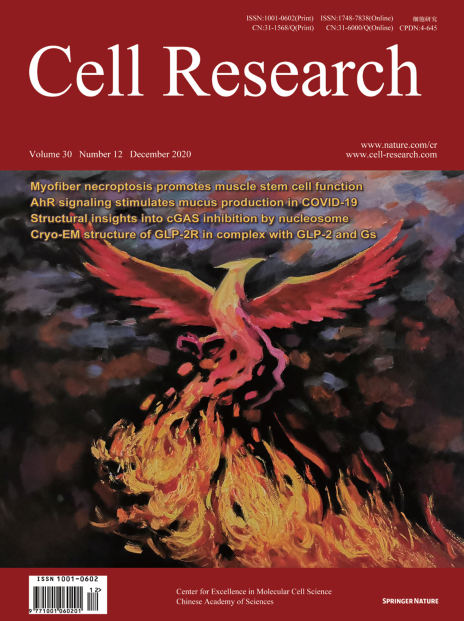
Advanced Search
Submit Manuscript
Advanced Search
Submit Manuscript
Volume 30, No 12, Dec 2020
ISSN: 1001-0602
EISSN: 1748-7838 2018
impact factor 17.848*
(Clarivate Analytics, 2019)
Volume 30 Issue 12, December 2020: 1063-1077 |
Myofiber necroptosis promotes muscle stem cell proliferation via releasing Tenascin-C during regeneration
Shen’ao Zhou1,2 , Wei Zhang1,2 , Gaihong Cai3 , Yingzhe Ding4,5 , Caixia Wei1 , Sheng Li1 , Yu Yang1,2 , Jie Qin1 , Dan Liu1 , Hao Zhang6 , Xiexiang Shao7 , Jianhua Wang7 , Hongye Wang1 , Wenjun Yang1 , Huating Wang4,8 , She Chen3,9 , Ping Hu1,2,10,11,12,13,* , Liming Sun1,2,10,*
1State Key Laboratory of Cell Biology, CAS Center for Excellence in Molecular Cell Science, Shanghai Institute of Biochemistry and Cell Biology, Chinese Academy of Sciences, University of Chinese Academy of Sciences, Shanghai 200031, ChinaNecroptosis, a form of programmed cell death, is characterized by the loss of membrane integrity and release of intracellular contents, the execution of which depends on the membrane-disrupting activity of the Mixed Lineage Kinase Domain-Like protein (MLKL) upon its phosphorylation. Here we found myofibers committed MLKL-dependent necroptosis after muscle injury. Either pharmacological inhibition of the necroptosis upstream kinase Receptor Interacting Protein Kinases 1 (RIPK1) or genetic ablation of MLKL expression in myofibers led to significant muscle regeneration defects. By releasing factors into the muscle stem cell (MuSC) microenvironment, necroptotic myofibers facilitated muscle regeneration. Tenascin-C (TNC), released by necroptotic myofibers, was found to be critical for MuSC proliferation. The temporary expression of TNC in myofibers is tightly controlled by necroptosis; the extracellular release of TNC depends on necroptotic membrane rupture. TNC directly activated EGF receptor (EGFR) signaling pathway in MuSCs through its N-terminus assembly domain together with the EGF-like domain. These findings indicate that necroptosis plays a key role in promoting MuSC proliferation to facilitate muscle regeneration.
https://doi.org/10.1038/s41422-020-00393-6